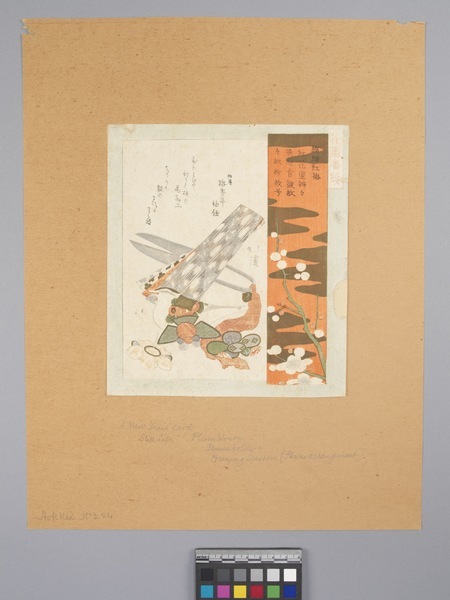Chirimen Kobai Item Number: 3212/2 from the MOA: University of British Columbia

Description
Colour woodblock print "Red Blossom Silk Crepes" from the Hanazono Bantsuzuki (Hanazono club) series. This surimono depicts a particular plum blossom species in the vertical panel, and a still life of silk crepes with images of plum blossoms, scissors, and ornaments in the shape of blossoms and birds.
History Of Use
A surimono 摺物 (literally, “printed things”) is a particular genre of Japanese woodblock print, and refers to privately commissioned or issued prints distributed in limited editions, mainly produced in the 1790s–1830s. They often include images and poetic inscriptions or verses. While surimono were designed in various sizes and formats, the design format was more or less standardized by around 1810. Shikishiban (c. 20.5 x 18.5 cm) was one of the standardized formats. Surimono were often commissioned as gifts or for special occasions such as the New Year; they were not sold to the public for commercial gain. The New Year is the most important holiday in Japan. Still life was a popular subject in surimono designs, but neglected in typical ukiyo-e prints.
Iconographic Meaning
The vertical panel has a text about a particular plum blossom species, and the large panel has a kyōka (狂歌, comic or satirical poem).
Narrative
Signed Hokkei (北渓) in the middle. Hanazono Bantsuzuki (花園番續) is a series made for the poetry club known as Hanazono-ren, led by the poet Garyôen Umemaro (臥龍園梅麿). His name, Umemaro, derives from one kind of Japanese plum. Around 20 designs are known from this series, in which each has a narrow vertical panel depicting a particular plum blossom species and a larger panel depicting a still life.
Item History
- Made by Hokkei Totoya (Maker) in Japan during 1823
- Owned by Morris and Helen Belkin Art Gallery before October 25, 2016
- Received from Morris and Helen Belkin Art Gallery (Transferring institution) on October 25, 2016
What
- Name
- Chirimen Kobai
- Identification Number
- 3212/2
- Type of Item
- Overall
- height 39.0 cm, width 30.5 cm
- Image
- height 20.7 cm, width 18.2 cm
Who
- Culture
- Japanese
- Creator
- Hokkei Totoya (Maker)
- Previous Owner
- Morris and Helen Belkin Art Gallery
- Received from
- Morris and Helen Belkin Art Gallery (Transferring institution)
Where
- Holding Institution
- MOA: University of British Columbia
- Made in
- Japan
When
- Creation Date
- during 1823
- Ownership Date
- before October 25, 2016
- Acquisition Date
- on October 25, 2016
Other
- Item Classes
- works on paper
- Condition
- good
- Accession Number
- 3212/0002